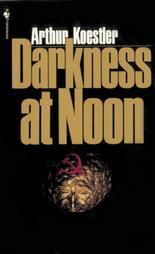Related Post:

Koestler, Arthur. Darkness at Noon
Translated by Daphne Hardy
Original publication date: 1940
Rpt. New York: Bantam Books, 1966
ISBN 0–553–26595–4
Originally written in German and translated into English by Koestler’s companion Daphne Hardy, Darkness at Noon was first published in 1940. Set in an unnamed country, the book is an allegory for the USSR’s 1938 purges during which Stalin worked to cement his position as dictator by eliminating potential rivals.
In an opening note Koestler wrote:
The characters in this book are fictitious. The historical circumstances which determined their actions are real. The life of the man N. S. Rubashov is a synthesis of the lives of a number of men who were victims of the so-called Moscow Trials. Several of them were personally known to the author. This book is dedicated to their memory.
 The main character, Nicholas Salmanovitch Rubashov, is imprisoned and tried for treason against the government that he helped to create. As he contemplates his life, Rubashov realizes the Party, which has been in power for 20 years, is no closer than it originally was to accomplishing its goal of creating a socialist utopia. He remembers, with some shame and guilt, his own earlier actions of betrayal that promoted the Party’s purposes.
The main character, Nicholas Salmanovitch Rubashov, is imprisoned and tried for treason against the government that he helped to create. As he contemplates his life, Rubashov realizes the Party, which has been in power for 20 years, is no closer than it originally was to accomplishing its goal of creating a socialist utopia. He remembers, with some shame and guilt, his own earlier actions of betrayal that promoted the Party’s purposes.
As he is interrogated, Rubashov initially refuses to admit to the trumped-up charges. Afterwards, the two interrogators, Gletkin and Ivanov, discuss Rubashov’s fate. Ivanov, the more intellectual of the two, is basically humane and disturbed by the suffering he causes. Ivanov represents the original Party supporters. Gletkin represents the younger generation of the Party elite moving to take over from the older generation. He favors more ruthless means of torture such as sleep deprivation and doesn’t care how he gets the confession he needs to establish his own position.
Eventually Rubashov admits to the false charges. The novel ends with his execution.
© 2016 by Mary Daniels Brown

